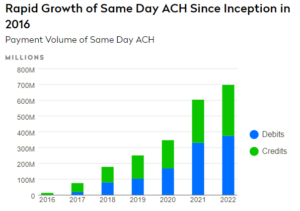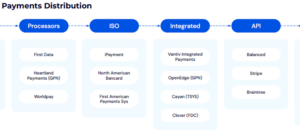The Rise of Embedded Finance and Open Banking
Bidding to serve a new generation of buyers, FinTech companies seek to redefine how financial services are delivered, especially payments. With the rise of ecommerce marketplaces, FinTechs are taking advantage of an opportunity to tap into new revenue streams by providing embedded finance and open banking services.
New regulatory guidance from three U.S. bank regulators may help.
Marketplaces act as catalysts for FinTechs looking to expand their reach and diversify revenue streams. These platforms bring together buyers and sellers, creating an ecosystem ripe with opportunities for financial services. FinTechs can provide payment processing, lending options, insurance services, and more, enhancing the overall customer experience.
To capitalize on this opportunity, communication between a company’s digital commerce team and its treasury team becomes crucial. That’s the primary message from a recent JP Morgan Payments webinar, “Future of Treasury: Growing the Value of Digital Marketplaces.”
Embedding Financial Services
Embedded finance refers to the integration of financial services into nonfinancial platforms such as ecommerce platforms and mobile applications. This integration enables seamless financial transactions within the customer’s journey, eliminating the need for third-party applications or separate financial service providers.
By embedding financial services directly into the platforms consumers already use, FinTechs can offer personalized, convenient, and realtime solutions. “More companies have realized that establishing that direct connection with their customers—be they consumers, businesses, small businesses—has huge benefits,” noted Isobel Clarke, a member of JP Morgan’s payments strategy team.
When discussing embedded finance and marketplaces, Helena Forest, JP Morgan’s head of product for EMEA marketplaces, discussed why companies are looking at this evolution of their business models. “The first one is absolutely the consumer’s preference.” Consumers are seeking even more convenience. “As Gen Zs are making decisions around buying new products and services, the majority happens absolutely online, and usually even on the go,” she said.
“In order to remain attractive, companies need to ensure they can meet those expectations and provide a convenient, personalized, and delightful way of engagement. This is what digital platforms are great for because you can continue to expand your offering with regards to products and services and continue to evolve that connection with your customer.”
Unlocking Open Banking Services
By embracing open banking, FinTechs can access a wealth of customer data, facilitating better financial decision-making and customized services. Integrating open banking services into marketplaces enables FinTechs to offer tailored financial solutions, such as personalized savings recommendations, budgeting tools, or instant loan approvals.
Open banking, widespread in Europe, allows third-party developers to access and utilize financial data through secure APIs, which provide a direct data connection between systems.
Regulation has been less clear in the United States. On June 9, 2023, however, the Federal Reserve System, Federal Deposit Insurance Corp, and Office of the Comptroller of the Currency published final risk management guidance on third-party relationships. Banking and FinTech organizations generally praised the guidance for its clarity.
Aligning with Treasury
To maximize the potential of marketplaces and embedded finance, FinTechs must integrate their ecommerce and digital team with their treasury team. Traditionally, these teams have operated independently, with limited collaboration.
However, companies can leverage synergies and streamline operations by aligning their efforts. The digital team brings expertise in customer experience, user interface, and product development, while the treasury team offers financial insights, risk management, and regulatory compliance knowledge.
Key Strategies for Integration
- Collaboration. Foster a culture of cooperation between the ecommerce, digital, and treasury teams. Encourage regular communication, knowledge sharing, and joint decision-making processes to ensure a comprehensive understanding of goals and challenges.
- Cross-functional Expertise. Encourage team members to develop a holistic understanding of both financial and digital aspects. This cross-pollination of knowledge and skills will enable the teams to develop innovative solutions and overcome potential roadblocks.
- Regulatory Compliance. Ensure compliance with relevant financial regulations and data privacy laws. Collaborate with legal and compliance experts to design robust frameworks that address potential risks and safeguard customer data.
- Scalable Infrastructure. Invest in scalable infrastructure capable of handling increased transaction volumes. A robust payment processing system, secure APIs, and data analytics capabilities are essential to support seamless integration with marketplaces.
“From the financial perspective, it’s going to completely change the way financial services are being accessed and offered,” Helena Forest said during the webinar. Embracing this convergence will enable FinTechs to stay ahead of the curve, drive innovation, and solidify their position in the fast-growing digital financial ecosystem.
– Brianna Smith
- SEO Powered Content & PR Distribution. Get Amplified Today.
- EVM Finance. Unified Interface for Decentralized Finance. Access Here.
- Quantum Media Group. IR/PR Amplified. Access Here.
- PlatoAiStream. Web3 Data Intelligence. Knowledge Amplified. Access Here.
- Source: http://www.fintechrising.co/harnessing-the-power-of-digital-marketplaces/
- :has
- :is
- 2023
- 9
- a
- absolutely
- access
- accessed
- Act
- address
- ADvantage
- ahead
- allows
- already
- an
- analytics
- and
- APIs
- applications
- approvals
- ARE
- around
- AS
- aspects
- At
- attractive
- Bank
- Banking
- because
- becomes
- been
- being
- benefits
- Better
- between
- both
- bring
- Brings
- budgeting
- business
- businesses
- buyers
- Buying
- by
- CAN
- capabilities
- capable
- capitalize
- catalysts
- challenges
- change
- clarity
- clear
- collaborate
- collaboration
- Commerce
- Communication
- Companies
- Company’s
- completely
- compliance
- comprehensive
- connection
- Consumers
- continue
- convenience
- Convenient
- Convergence
- cooperation
- Corp
- Creating
- crucial
- Culture
- Currency
- curve
- customer
- customer data
- customer experience
- customized
- data
- Data Analytics
- data privacy
- Decision Making
- decisions
- delightful
- delivered
- deposit
- DEPOSIT INSURANCE
- Design
- develop
- developers
- Development
- digital
- digital commerce
- direct
- directly
- discussed
- discussing
- diversify
- drive
- during
- ecommerce
- ecosystem
- efforts
- eliminating
- embedded
- Embedded Finance
- embracing
- EMEA
- enable
- enables
- encourage
- engagement
- enhancing
- ensure
- especially
- essential
- establishing
- Europe
- Even
- evolution
- evolve
- Expand
- expectations
- experience
- expertise
- experts
- facilitating
- Federal
- federal reserve
- final
- finance
- financial
- financial data
- financial service
- financial services
- fintech
- Fintech Companies
- fintechs
- First
- For
- forest
- Foster
- frameworks
- from
- Gen
- generation
- Go
- Goals
- going
- great
- Growing
- guidance
- Handling
- happens
- Harnessing
- Have
- head
- help
- holistic
- How
- However
- http
- HTTPS
- huge
- in
- increased
- independently
- Infrastructure
- Innovation
- innovative
- insights
- instant
- insurance
- integrate
- Integrating
- integration
- Interface
- into
- Invest
- ITS
- joint
- journey
- jp morgan
- JPMorgan
- june
- knowledge
- Laws
- Legal
- lending
- less
- Leverage
- Limited
- loan
- looking
- Majority
- Making
- management
- marketplaces
- Maximize
- May..
- Meet
- member
- Members
- message
- Mobile
- Mobile Applications
- models
- more
- Morgan
- must
- Need
- New
- new products
- noted
- of
- offer
- offered
- offering
- Offers
- Office
- on
- ONE
- online
- open
- open banking
- operated
- Operations
- opportunities
- Opportunity
- Options
- or
- order
- organizations
- overall
- Overcome
- payment
- payment processing
- payments
- Personalized
- perspective
- Platforms
- plato
- Plato Data Intelligence
- PlatoData
- position
- potential
- power
- primary
- privacy
- processes
- processing
- Product
- product development
- Products
- provide
- providers
- providing
- published
- reach
- realized
- realtime
- recent
- recommendations
- refers
- regards
- regular
- regulations
- Regulators
- regulatory
- Regulatory Compliance
- relevant
- remain
- Reserve
- Reserve system
- revenue
- Rise
- Risk
- risk management
- risks
- roadblocks
- robust
- s
- Said
- Savings
- scalable
- seamless
- secure
- Seek
- seeking
- Sellers
- separate
- serve
- service
- service providers
- Services
- sharing
- she
- skills
- small
- Solutions
- States
- stay
- strategies
- Strategy
- streamline
- streams
- such
- support
- system
- Systems
- tailored
- taking
- Tap
- team
- Team members
- teams
- that
- The
- their
- These
- they
- third-party
- this
- those
- three
- Through
- to
- together
- tools
- traditionally
- transaction
- Transactions
- treasury
- u.s.
- U.S. Bank
- understanding
- United
- United States
- use
- User
- User Interface
- usually
- utilize
- value
- volumes
- Way..
- Wealth
- webinar
- What
- which
- while
- why
- widespread
- will
- with
- within
- You
- Your
- zephyrnet










